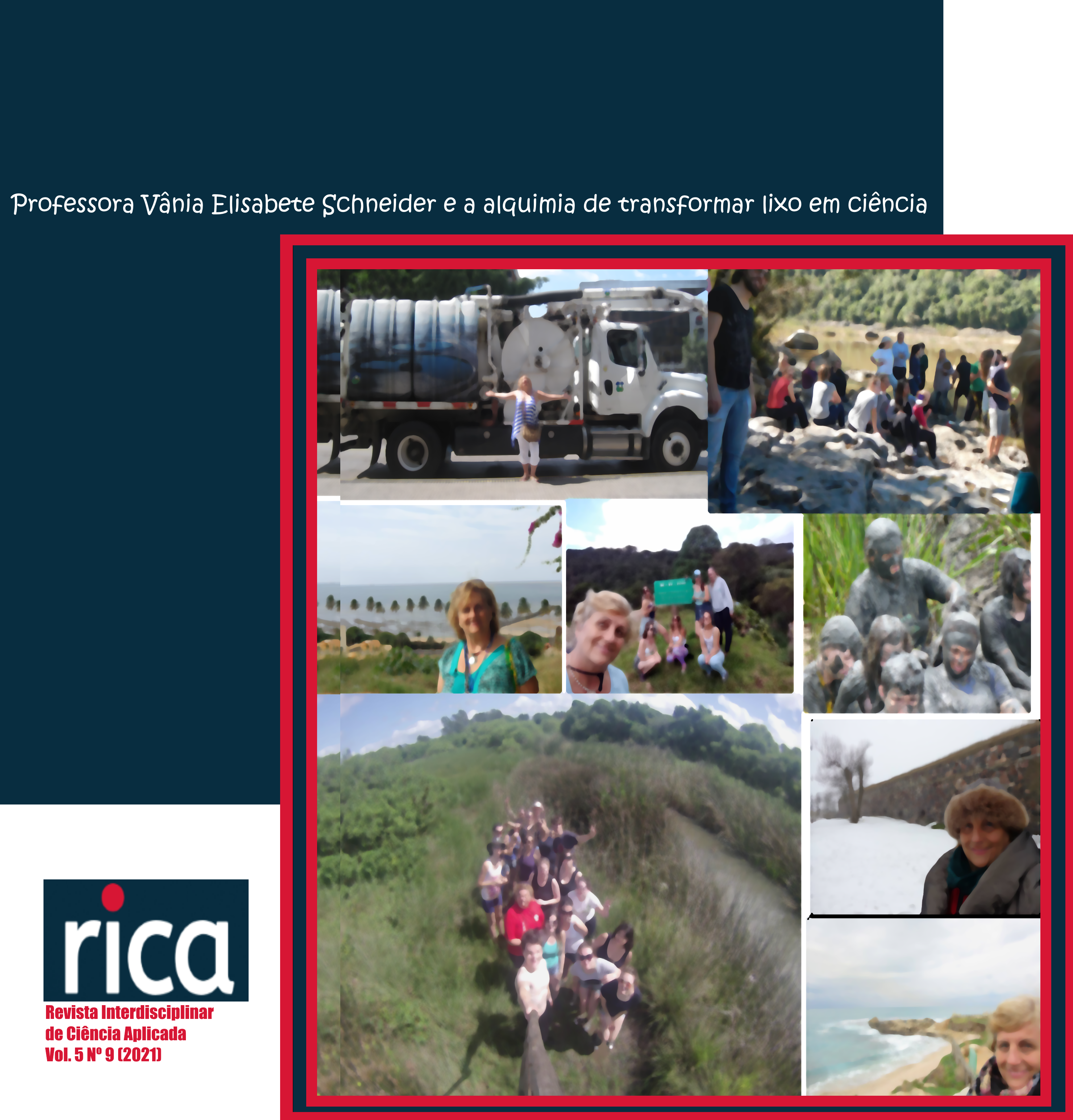Impact of soil management on the physical properties of an ferralsol from the ‘Campos de Cima da Serra’ region, Rio Grande do Sul
DOI:
https://doi.org/10.18226/25253824.v5.n9.04Keywords:
soil management, water infiltration, soil penetration, infiltration speedAbstract
The expansion of cultivation areas, especially in the last decade, has changed the landscapes of ‘Campos de Cima in Serra’ of
Rio Grande do Sul state, where livestock activity has been developing for 300 years. The introduction of silviculture, grain crops, and
orchards, in addition to the cultivation of vegetables, have imposed different managements on the soils, ranging from direct planting to the use of rotary hoes. This work sought to evaluate the impact of different types of soil management on the physical properties and water infiltration capacity of a ferralsol, typical of this region of the north of Rio Grande do Sul state. The soil under the management of native grazing fields showed lower particle and bulk densities and resistance to penetration, while soil planted on garlic crops showed greater resistance to penetration, particle and bulk densities, and lower total porosity and macroporosity. The average infiltration speed was 29.2 mm∙h-1 for the native field under grazing (T1), 65.4 mm∙h-1 for planting on soybean straw (T2), and 20.0 mm∙h-1 for planting on garlic crop (T3). It was observed that intensive management, such as the use of the rotary hoe, had a considerable negative impact on the physical properties and the speed of water infiltration in the soil and, consequently, potential damage to the replenishment of underground deposits, when compared with direct planting and the native field.
References
LOPES, F., MIELNICZUK, J., OLIVEIRA, E. S., & TORNQUIST, C. G. (2010). Evolução do uso do solo em uma área piloto da região de Vacaria, RS. Revista Brasileira de Engenharia Agrícola e Ambiental, 14, 1038-1044.
PILLAR, V. P., MÜLLER, S. C., CASTILHOS, Z. M. S., & JACQUES, A. V. A. (2009). Campos Sulinos: conservação e uso sustentável da biodiversidade. Brasília: MMA. 403 p.
BARCELOS, A. A., CASSOL, E. A., & DENARDIN, J. E. (1999). Infiltração de água em um latossolo vermelho-escuro sob condições de chuva intensa em diferentes sistemas de manejo. Revista Brasileira de Ciência do Solo, 23, 35-43.
NETTO, A. A., & FERNANDES, E. J. (2005). Avaliação da taxa de infiltração de água em um latossolo vermelho submetido a dois sistemas de manejo. Irriga, 10, 107-115.
WHITE, R. E. (2009). Princípios e Práticas da Ciência do Solo: o solo como recurso natural. 4 ed. São Paulo: Andrei Editora Ltda.
TROEH, F. R., & THOMPSON, L. M. (2007). Solos e Fertilidade do Solo. 6 ed. São Paulo: Andrei Editora Ltda. [7] BERTONI, J., & LOMBARDI NETO, F. (2008). Conservação do Solo. 6 ed. São Paulo: Ícone.
EMPRESA BRASILEIRA DE PESQUISA AGROPECUÁRIA. (1997). Manual de métodos de análise de solo. 2 ed. Rio de Janeiro: EMBRAPA-CNPS. 212 p.
TORMENA, C. A., BARBOSA, M. C., COSTA, A. C. S., & GONÇALVES, A. C. A. (2002). Densidade, porosidade e resistência a penetração em latossolo cultivado sob diferentes sistemas de preparo do solo. Sciencia Agrícola, 59(4), 795-801.
BAUMHARDT, R. L., & LASCANO, R. J. (1996). Effects of crop residue on soil and plant water evaporation in a dryland cotton system. Theoretical and Applied Climatology, 54, 69-84.
STEINER, J. L. (1989). Tillage and surface residue effects on evaporation from soils. Soil Science Society of America Journal, 53, 911-916.
TEDESCO, M. J., GIANELLO, C., BISSANI, C. A., BOHNEN, H., & WOLKWEISS, S. J. (1995). Análises de solo, plantas e outros materiais. Boletim técnico 5. 2 ed. Porto Alegre: UFRGS. 174 p.
EMPRESA BRASILEIRA DE PESQUISA AGROPECUÁRIA. (2006). Sistema Brasileiro de Classificação de Solos. 2ª edição. Rio de Janeiro: Embrapa Solos.
STRECK, E. V., KÄMPF, N., DALMOLIN, R. S. D., KLAMT, E., NASCIMENTO, P. C., SCHNEIDER, P., GIASSON, E., & PINTO, L. F. S. (2008). Solos do Rio Grande do Sul. 2 ed. Porto Alegre: EMATER – RS/ASCAR.
COMISSÃO DE QUÍMICA E FERTILIDADE DO SOLO. (2016). Manual de adubação e calagem para os Estados do Rio Grande do Sul e Santa Catarina. 2ª ed. Porto Alegre: SCBS-NRS.
SILVEIRA, D. C., MELO FILHO, J. F., SACRAMENTO, J. A. A. S., & SILVEIRA, E. C. P. (2010). Relação umidade versus resistência à penetração para um argissolo amarelo distrocoeso no recôncavo da Bahia. Revista Brasileira de Ciência do Solo, 34, 659-667.
FERREIRA, T. R., PIRES, L. F., AULER, A. C., BRINATTI, A. M., & OGUNWOLE, J. O. (2019). Water retention curve to analyze soil structure changes due to liming. Anais da Academia Brasileira de Ciências, 91(3), e20180528.
STONE, L. F., GUIMARÃES, C. M., & MOREIRA, J. A. A. (2002). Compactação do solo na cultura do feijoeiro. I: efeitos nas propriedades físico-hídricas do solo. Revista Brasileira de Engenharia Agrícola e Ambiental, Campina Grande, 6(2), 207-212.
MENDONÇA, L. A. R., VÁSQUEZ, M. A. N., FEITOSA, J. V., OLIVEIRA, J. F., FRANCA, R. M., VÁSQUEZ, E. M. F., & FRISCHKORN, H. (2009). Avaliação da Capacidade de Infiltração de Solos Submetidos a Diferentes Tipos de Manejo. Engenharia Sanitária e Ambiental, 14, 89-98.
DENARDIN, J. E., & KOCHHANNU, R. A. (1999). Fast no-till adoption in Brazil without subsidies: a successful partnership. Available at: <http://pnwsteep.wsu.edu/directseed/conf99/dspropBr.htm>. Accessed on 15 Feb. 2021.
Downloads
Published
How to Cite
Issue
Section
License
Copyright (c) 2021 Interdisciplinary Journal of Applied Science

This work is licensed under a Creative Commons Attribution-NonCommercial-NoDerivatives 4.0 International License.
Authors keep the copyright and cede to the journal the right of publishing first. Published works are licensed under a Creative Commons Attribution 4.0 International (CC BY 4.0) license, allowing the sharing of the work with recognition of the authorship and initial publication in this journal.






